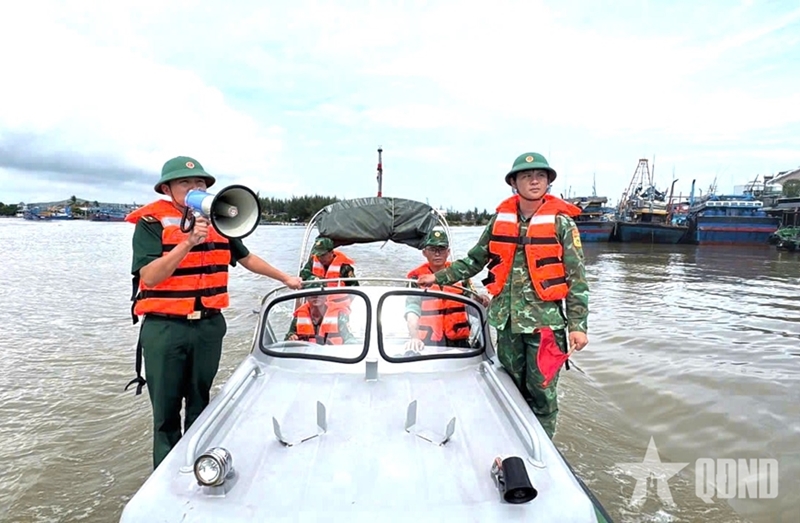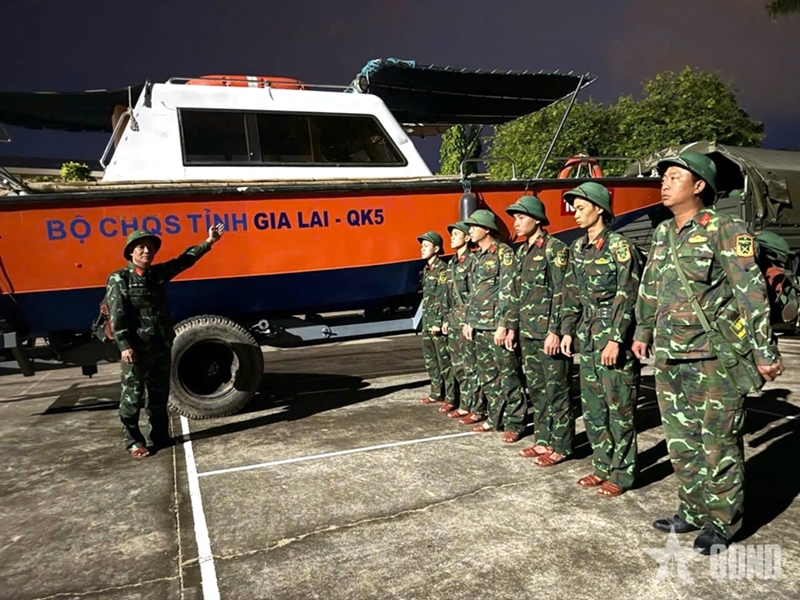Dual-purpose community infrastructure needed
“Community houses” and “Community shelters” have become familiar concepts to many people in Central Vietnam. These are community projects for disaster prevention and control implemented by the Central Vietnam Disaster Prevention Support Fund in collaboration with local authorities, enterprises, and military units.
In the recent storms and floods, the dual-purpose value of these facilities became evident. Examples include the storm and flood shelters in Hoa Vang district and the Dai Hoa Kindergarten in Dai Loc district, Da Nang. Local officials and residents all emphasized the practicality and effectiveness of these “two-in-one” structures.
    |
 |
|
Border Guards in Quang Ngai Province call and guide fishing vessels to safe anchorage ahead of Typhoon No.13. |
Comrade Thai Dai Ngoc, Secretary of the Gia Lai Provincial Party Committee, who previously served as Commander of Military Region 5, used to visit disaster-prone areas and is well aware of the benefits of such dual-use facilities. He stressed that localities should mobilize organizations and benefactors to work with Party committees and authorities to build more community-based disaster prevention projects.
Central Vietnam residents, accustomed to extreme weather, have developed many adaptive strategies. Coastal families prepare shelters and small boats, stockpile essential goods, and place them in sturdy homes for use during storms. In highland communes, where rivers and roads are prone to isolation, residents reinforce their houses and move livestock and essential supplies to higher ground. Those in low-lying areas near rivers equip themselves with life jackets, flashlights, and boats to ensure safety.
Colonel Dang Ngoc Toan, Head of the Defensive Area Command Region 3-Tra My of the Da Nang Municipal Military Command, recalled the landslide in Tra Leng in 2020 that left dozens of people killed or missing. He noted that residents are now highly alert, storing enough food, water, and fuel for at least a week in homes, fields, or watchtowers. Water is kept in 20–30 liter plastic containers half-buried underground, while rice, instant noodles, oil, and dried food are wrapped in multiple layers of plastic and hung in rafters or trees, replaced every one to two months. Recent house construction follows the “three-solid” principle of solid foundation, solid walls, and solid roof.
Pro-active core forces
The armed forces have long been the core and vanguard in disaster prevention and control, working closely with residents in natural disaster response and times of hardship. To fulfill this role, training is crucial so that officers and soldiers have comprehensive knowledge and practical skills, acting as a firm shield for the people.
    |
 |
|
Officers and soldiers of the Gia Lai Provincial Military Command prepared to be deployed to high-risk areas to respond to Typhoon No.13 |
Senior Colonel Dinh Van Hung, Political Commissar of the Dak Lak Provincial Military Command, emphasized that “learning to live with storms and floods is inevitable in a disaster-prone country like Vietnam. To effectively respond to natural disasters, we must focus on training core forces capable of meeting the demands of this work. Military academies must equip officers with both technical expertise and leadership capacity to manage and execute disaster prevention tasks effectively.”
When storms, floods, or landslides occur, the armed forces must swiftly respond and help residents overcome consequences. In addition to pro-actively preparing plans, equipment, and materials, intensive training and drills, particularly for militia and self-defense forces, must be strengthened to ensure smooth coordination and proficiency in search and rescue, transport, first aid, vehicle operation, and water rescue.
During recent storms and floods, military units effectively supported residents thanks to prior drills and preparation. Before Typhoon No.13, Military Region 5 pre-deployed troops to high-risk areas for rapid and efficient response.
Promoting individual preparedness
In recent working sessions with Party committees, authorities, and forces of Central provinces and cities on storm response, Deputy Chief of the General Staff Lieutenant General Le Quang Dao stressed the importance of the “Five Selfs” (self-reliance, self-strengthening, self-care, self-preparation, and self-protection). To protect their lives and property, residents must enhance their capacity for adaptation, self-rescue, and survival skills, avoiding complacency or reliance solely on authorities.
Experts recommended integrating basic disaster prevention knowledge into school curricula and increasing public training to raise awareness and preparedness skills.
    |
 |
|
Before Typhoon No.13 struck, the Gia Lai Provincial Military Command had already sent troops in advance in vulnerable zones. |
Lieutenant Colonel Nguyen Ngoc Duong, Head of Cat Khanh Border Post of the Gia Lai Provincial Border Guard Command, noted that fishermen often hesitate to evacuate, hoping to protect boats and cages. Despite warnings, some return to their vessels, posing safety risks. In response, the border post has coordinated with local authorities to promote awareness campaigns and inspection of ports, boats, fish cages, and evacuation areas to prevent unauthorized movements during storms.
Translated by Tran Hoai